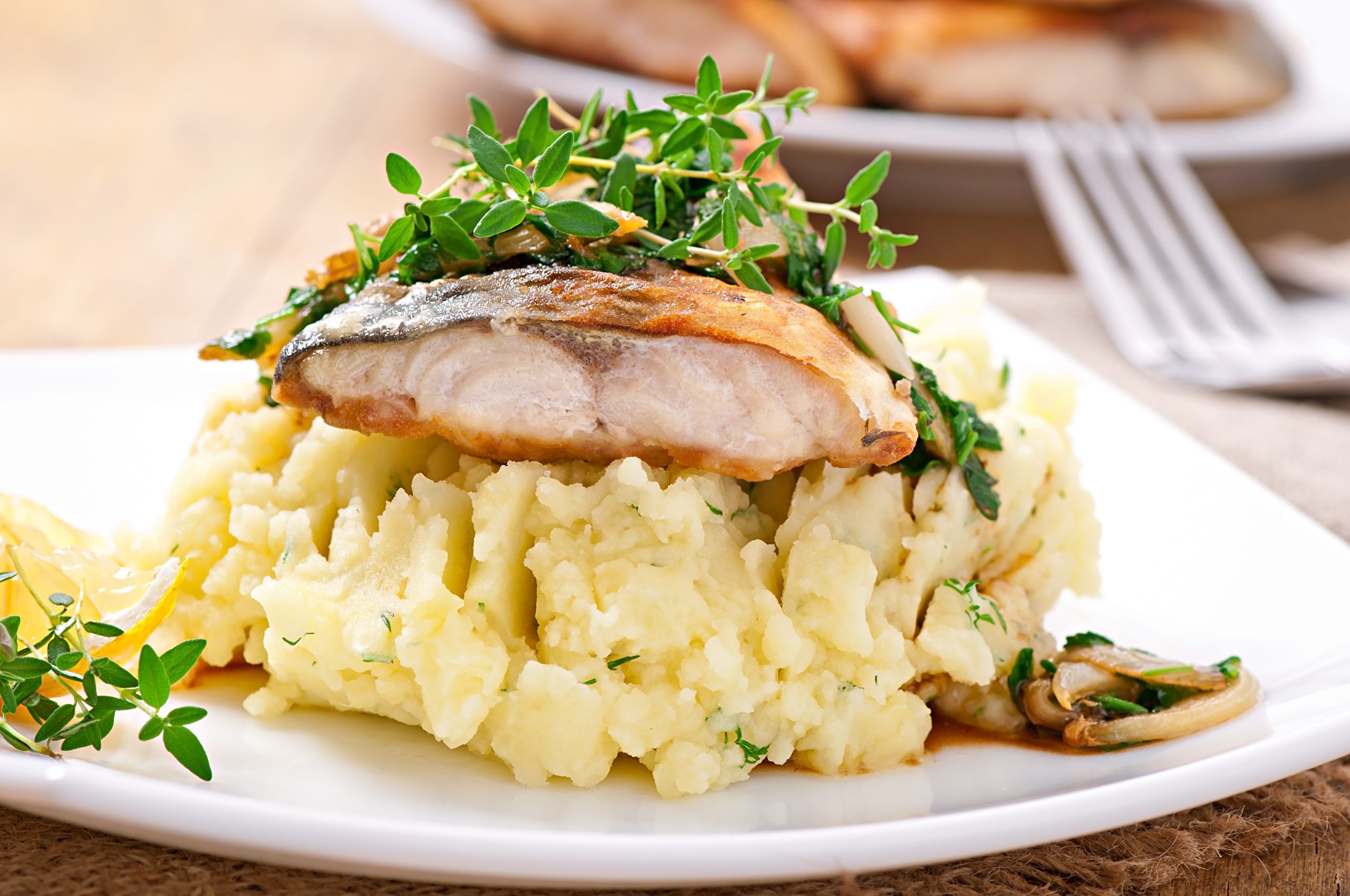Haddock is a popular fish eaten in many places in the Northern Atlantic Ocean. Melanogrammus aeglefinus, their scientific name, comes from the Greek word melanogrammus, which means “black line.” This fish lives in the ocean and belongs to the cod family.
Haddock can be found close to the seafloor, where it can eat small fish, crustaceans, and prawns, which are fish food. Younger fish eat smaller food items including copepods, plankton, and fish larvae.
Sand eels, worms, sea urchins, and capelins are some of the elder haddock’s predatory species. Haddock is a deep-sea fish that thrives in waters that are between 50 and 300 meters deep and over 2 degrees Celsius in temperature.
What is Haddock?
Haddock is a type of saltwater fish that belongs to the Gadidae family. It is commonly found in the North Atlantic Ocean, particularly in the waters of the northeastern United States, Canada, and Europe. Haddock is a popular seafood choice known for its mild and slightly sweet flavor, delicate texture, and versatility in cooking.
Here are some key characteristics of haddock:
- Appearance: Haddock has a distinctive appearance with a streamlined body and a slightly flattened head. Its coloration is greyish to brownish on the upper side and silvery-white on the belly. Haddock can grow to a length of about 1 meter (3 feet) and weigh up to several kilograms.
- Flavor and Texture: Haddock has a mild and clean flavor compared to some other fish varieties. Its flesh is lean, tender, and flaky, making it suitable for a wide range of culinary preparations. The texture is firm yet delicate, and it holds together well during cooking.
- Culinary Uses: Haddock is a versatile fish that can be cooked in various ways. It can be baked, grilled, broiled, poached, or fried. Haddock is commonly used in fish and chips, where it is coated in a crispy batter and deep-fried. It is also a popular choice for fish stews, chowders, and seafood soups.
- Nutritional Profile: Haddock is a nutritious fish that offers several health benefits. It is a good source of lean protein, vitamins (including vitamin B12), and minerals such as selenium and phosphorus. Haddock is also relatively low in calories and fat compared to some other fatty fish species.
Haddock is widely available in many seafood markets and grocery stores, often sold fresh, frozen, or smoked. When purchasing haddock, it’s important to look for fresh and properly handled fish to ensure its quality. The mild flavor and delicate texture of haddock make it a popular choice for seafood enthusiasts and a versatile ingredient in various culinary dishes.
What Does Haddock Taste Like?
Haddock has a mild and slightly sweet flavor, often described as clean and fresh. Its taste is generally less assertive compared to some other fish varieties. The flesh of haddock is delicate and tender, with a firm texture that flakes easily. The flavor profile is often described as clean and oceanic, with subtle hints of sweetness.
When cooked, haddock retains its mild flavor and does not overpower the dish it is used in. This makes it a versatile fish that can be paired with a wide range of flavors and seasonings. Haddock’s mild taste and delicate texture make it appealing to those who prefer a less pronounced seafood flavor.
Overall, the flavor of haddock is pleasant and well-suited for various cooking methods, allowing it to take on the flavors of accompanying ingredients while still maintaining its subtle character. It is a popular choice for those who enjoy seafood but prefer a milder taste experience.
What are the Health Benefits of Consuming Haddock?
Consuming haddock as part of a balanced diet can provide several health benefits due to its nutritional composition. Here are some potential health benefits of consuming it:
- Rich in Lean Protein: Haddock is a good source of high-quality protein, which is essential for building and repairing tissues, supporting muscle growth, and maintaining overall health. Protein is also important for promoting satiety and aiding in weight management.
- Essential Vitamins and Minerals: Haddock is a natural source of various vitamins and minerals. It is particularly rich in vitamin B12, which is important for red blood cell production, nerve function, and DNA synthesis. It also provides selenium, which is an antioxidant mineral that supports immune function and helps protect cells from damage.
- Omega-3 Fatty Acids: While haddock is not as high in omega-3 fatty acids as some other fatty fish species like salmon or mackerel, it still contains beneficial amounts. Omega-3 fatty acids, specifically EPA (eicosapentaenoic acid) and DHA (docosahexaenoic acid) are associated with various health benefits, including supporting heart health, reducing inflammation, and promoting brain function.
- Low in Calories and Fat: It is relatively low in calories and fat compared to some other fish varieties. It is a lean fish that can be incorporated into a balanced diet, making it suitable for individuals aiming to manage their calorie intake or control their fat consumption.
- Source of Minerals: Haddock provides important minerals such as phosphorus, which is essential for bone health and energy metabolism, and iodine, which is necessary for proper thyroid function and the production of thyroid hormones.
Is Haddock Expensive?
The price of haddock can vary depending on several factors, including geographical location, seasonality, availability, and the fish market you purchase it. Generally, haddock is considered to be a moderately priced fish compared to some other seafood options.
The cost of haddock can also be influenced by whether it is sold fresh, frozen, or smoked. Fresh haddock is typically more expensive than frozen or smoked varieties due to the added convenience and shorter shelf life. Smoked haddock, often used in specialty dishes like the traditional British dish “smoked haddock and poached egg,” may have a slightly higher price due to the smoking process.
It’s worth noting that prices can fluctuate based on supply and demand, so it’s best to check with local seafood markets or grocery stores to get accurate pricing information in your specific area. Additionally, haddock prices may vary in different regions or countries, depending on the local fishing industry and market conditions.
When purchasing, it’s important to consider factors beyond price, such as freshness, quality, and sustainability. Ensuring that the fish is sourced from reputable suppliers and caught using sustainable fishing practices can also contribute to the overall value and impact of your purchase.
Is It Safe To Eat Too Much Haddock?
Consuming haddock in moderation as part of a balanced diet is generally safe and can provide various health benefits. However, it’s important to be mindful of potential risks associated with consuming excessive amounts of any food, including it.
Here are a few considerations:
- Mercury Content: Like much other fish, haddock may contain trace amounts of mercury, a naturally occurring element found in water bodies. While the mercury levels in haddock are generally considered to be low, it is advisable to be cautious, especially for certain vulnerable groups. Pregnant women, nursing mothers, and young children are typically advised to limit their intake of fish with higher mercury levels to minimize potential developmental risks. Consulting with a healthcare professional or referring to local dietary guidelines can provide specific recommendations for your situation.
- Overall Diet and Variety: It is important to maintain a varied and balanced diet that includes a wide range of foods from different food groups. Relying solely on it or any single food as a primary protein source may lead to an imbalanced nutrient intake. Incorporating a variety of seafood, lean meats, legumes, dairy, fruits, vegetables, whole grains, and other nutrient-dense foods is recommended for optimal nutrition.
- Cooking and Preparation Methods: The way it is cooked and prepared can also impact its nutritional value. Deep-frying or heavily breading the fish can significantly increase the calorie and fat content, potentially negating some of the health benefits. Opting for healthier cooking methods such as baking, grilling, or steaming can help maintain the nutritional integrity of the fish.
As with any dietary considerations, it is important to take into account individual factors such as age, overall health, specific dietary needs, and any pre-existing conditions. Consulting with a healthcare professional or registered dietitian can provide personalized advice and guidance based on your specific circumstances.
Conclusion
Haddock is a versatile and popular saltwater fish known for its mild, slightly sweet flavor and delicate, flaky texture. It offers several potential health benefits as part of a balanced diet, including being a good source of lean protein, essential vitamins (such as B12), minerals (like selenium and phosphorus), and omega-3 fatty acids.
Haddock is relatively low in calories and fat, making it suitable for those watching their calorie and fat intake. As with any dietary considerations, it is advisable to consult with a healthcare professional or registered dietitian for personalized advice based on individual circumstances and health requirements.


